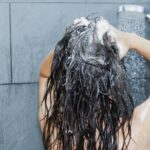Hair styling products, environmental pollution, and sweat can seep into the scalp, hindering the healthy development of hair. There are some signs that may indicate the accumulation of oil and excess sebum on the scalp and it is time to detox:
– Itchy scalp
Itchy and flaky scalp is a sign that the hair follicles are severely clogged or may be dandruff.

– Oily scalp, greasy hair
An oily scalp is a sign of imbalance. The sebaceous glands are overly active on the scalp, producing too much oil, which can accumulate at the hair roots.
– Scalp odor
A healthy scalp should not have any odor. If you notice a quick onset of scalp odor after washing, it may be a sign of accumulated oil that needs to be removed.
Just shampooing is not enough to deep cleanse the scalp, so it is recommended to undergo detoxifying treatments to restore the health of the hair. Hair detox is a deep cleansing of the scalp and hair to renew and restore their health, as recommended by experts.
Hair care tips
– Deep hair cleansing
Use shampoos that contain deep cleansing ingredients such as acids or enzymes to remove excess sebum and residual substances.
– Clean hair from within
Change your diet and overall health care to provide nutrients to the hair from within, making the hair healthy and shiny.
– Use detoxifying products
Before using any product, make sure it does not harm health or cause skin irritation.
– Natural cleansing methods
Some people prefer natural methods such as washing hair with baking soda or rinsing hair with lemon water, which are also effective ways to detoxify the hair.

Natural hair detox tips
The most common causes of hair damage are excessive use of chemical hair styling products, hair dyeing, and bleaching. You should stop using them to reduce damage, trim the hair to remove split ends and damaged portions, and then proceed with hair and scalp detoxification by:
Castor oil and coconut oil
Heat and apply to the hair. Then soak a towel in hot water, squeeze it dry, and wrap it around the head like a turban. Leave it on for 5 minutes and repeat the towel wrapping 3 or 4 times.
Baking soda
Mix half a cup of baking soda with 3 cups of warm water and massage the scalp with this mixture for a few minutes, then rinse thoroughly. It will remove the oil build-up on the scalp and prevent dandruff. Can be used once a week.
Apple cider vinegar
Mix 2 tablespoons of apple cider vinegar with a cup of water. Shampoo and condition your hair as usual, then pour the diluted apple cider vinegar on the hair. This is the easiest way to detoxify and can be used once a week.
Additionally, you can detoxify your hair with herbal tea. Brew the tea with a tablespoon of herbs such as thyme, chamomile, which have detoxifying properties and provide a relaxing sensation.
Note that if you have scalp conditions such as seborrheic dermatitis, psoriasis, eczema, or hair loss disorders, it is advised to consult a dermatologist.
Tips to Avoid Dandruff During Monsoon Season
During the rainy season, fungal infections of the scalp are one of the most common issues caused by high humidity and warm weather. Thankfully, there are some effective ways to combat scalp fungus and reduce the associated itchiness. In this article, we’ll explore a few helpful tips for protecting your scalp against fungal infections.






































